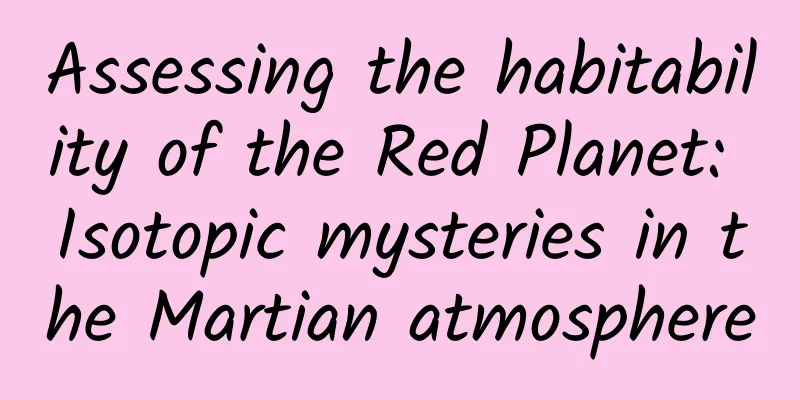Assessing the habitability of the Red Planet: Isotopic mysteries in the Martian atmosphere

|
Mars, also known as the "Red Planet", has attracted the interest of scientists and space enthusiasts since ancient times. Its similarity to Earth and the possibility of past or even present life on its surface have triggered many robotic exploration missions to reveal the mysteries behind it. One of the important missions, the ExoMars Trace Gas Orbiter, recently provided us with important insights into the composition of the Martian atmosphere and the origin of organic matter on the surface. 1. Multiple robotic explorations reveal mysteries of Mars At this moment, there are 11 robotic missions exploring Mars, including orbiters, landers, rovers, and one air vehicle (the Perseverance rover). Like their predecessors, these missions are dedicated to studying the atmosphere, surface, and subsurface of Mars to understand its past and evolution, including its transformation from a once warm and wet environment to the cold, dusty, and extremely dry planet it is today. In addition, these missions are looking for signs of life that may have existed on Mars in the past, or even clues as to whether life still exists on Mars. 2. Insight into the composition of Mars’ gas One particularly compelling question is the Martian atmosphere, which is mostly made up of carbon dioxide (CO2) and is relatively rich in carbon-13 (13C), an isotope of "heavy carbon." For years, scientists have speculated that this isotope ratio might be associated with organic matter on the surface (a sign of biological processes!). But after analyzing data from the European Space Agency's (ESA) ExoMars Trace Gas Orbiter (TGO) mission, an international team led by The Open University (The Open University) has determined that these organics are likely of "abiotic origin" (i.e., non-biological nature). The research was led by Juan Alday, a postdoctoral researcher at The Open University, with participation from members of its Atmospheric Research and Surface Exploration group. They were also supported by the Russian Space Research Institute (IKI), the Atmosphere, Media and Space Observation Laboratory (LATMOS) at École Polytechnique in France, and the Atmospheric, Oceanic and Planetary Physics Group (AOPP) at the University of Oxford in the United Kingdom. Their findings are reported in a paper titled "Photochemical depletion of heavy CO isotopes in the Martian atmosphere," which was recently published in the journal Nature Astronomy. Figure 1. NASA's Mars rover "Perseverance" has successfully landed on the surface of Mars and sent back the first batch of Mars images, becoming NASA's fifth Mars rover to successfully land (Image source: NASA) 3. Detecting the Martian atmosphere using isotope geochemistry Of the gases in the Martian atmosphere, carbon dioxide makes up about 96%, while carbon monoxide accounts for a tiny fraction (0.0557%). The relative abundance of heavy carbon isotopes in these gases (which make up only 1.1% of carbon isotopes in Earth's atmosphere) has been attributed to the preferential escape of "light carbon" (12C) to space over billions of years. This is based in part on recent measurements by NASA's Curiosity rover, which revealed the depletion of 13C in surface organic matter (methane gas). By analyzing this isotopic enrichment, scientists hope to gain a deeper understanding of atmospheric processes that evolve the "isotope ratio" between the upper and lower atmosphere. Because carbon monoxide (CO) and organic molecules in the atmosphere share the same 13C-depleted isotope signature, scientists hope to find clues about whether organic processes (possibly an indication of life) are at work. To conduct their research, a team led by Dr. Alday examined vertical profile data of CO acquired by TGO's Atmospheric Chemistry Suite (ACS). The suite consists of three infrared Echelle spectrometers covering near infrared (NIR), mid infrared (MIR) and far infrared (TIRVIM) channels. Since 2016, these instruments have been collecting spectral data from the Martian atmosphere, using absorption lines that indicate the presence of different chemical elements to determine its composition. The team then combined this data with a photochemical model that predicts the depletion of carbon and oxygen from CO molecules in the atmosphere due to interaction with solar radiation. Their results suggest that (contrary to previous thinking) the carbon monoxide (CO) in the Martian atmosphere is low in abundance in heavy carbon, while light carbon is abundant. As Dr. Arday explained in a UK Open University press release: "The key to understanding why there is less 13C in CO lies in the chemical relationship between CO2 and CO. When sunlight breaks CO2 molecules into CO, 12CO2 molecules are destroyed more efficiently than 13CO2 molecules, resulting in a long-lasting depletion of 13C in CO." Figure 2. 95% of the Martian atmosphere is carbon dioxide (CO2) and only 0.14% is oxygen (O2) (Image source: NASA) These findings help resolve a long-standing controversy over whether organic matter on the Martian surface was formed by biological or abiotic processes. Although the amounts of carbon monoxide in the Martian atmosphere are minuscule, they are important for our understanding of how the Martian atmosphere and climate have evolved over time. On the one hand, they can reveal conditions under which flowing and stationary bodies of water existed in the past. On the other hand, although these findings may be disappointing, they help further the search for past life on Mars. Dr. Arday said the ultimate goal is to determine whether conditions suitable for life existed on the planet and whether they lasted long enough for life to emerge: "We don't know what the atmosphere of early Mars was like, or what conditions allowed liquid water to flow on the surface. Carbon isotopes in the Martian atmosphere can help us estimate how much CO2 was in the atmosphere in the past. New measurements from ExoMars TGO show that less CO2 escaped to space than previously estimated, providing new constraints on the composition of the early Martian atmosphere." This research was made possible thanks to support from the UK Space Agency, which funded research for the ACS spectrometer and the Atmospheric Research and Surface Exploration group. TGO is part of the larger ExoMars program, a collaboration between the European Space Agency (ESA) and the Russian space agency Roscosmos. The program will send the Rosalind Franklin rover to Mars in the coming years, further aiding the ongoing search for past (and possibly present) life on Mars. (End) Original article: Alday, J., Trokhimovskiy, A., Patel, MR, Fedorova, AA, Lefèvre, F., Montmessin, F., ... Shakun, A. (2023). Photochemical depletion of heavy CO isotopes in the Martian atmosphere. Nature Astronomy, 7, 867-876. Link: https://www.nature.com/articles/s41550-023-01974-2 The article is translated and organized based on the following content: ExoMars Trace Gas Orbiter analyzes the martian atmosphere. Credit: ESA/ATG medialab, POSTED ON MAY 17, 2023 BY MATT WILLIAMS. https://www.universetoday.com/161402/life-probably-didnt-have-a-hand-in-creating-organic-deposits-on-the-surface-of-mars/ . |
<<: Pay attention to this word on the CT report! It is likely to be cancer, don't take it lightly!
>>: “Immune gap” VS “immune deficiency”: Who is more reasonable?
Recommend
Lin Sien·"Whole Brain Parenting" Intensive Reading Class
Lin Sien·"Whole Brain Parenting" Intens...
SiriOS may be released soon to help Apple's smart home ecosystem
Following iOS, MacOS, watchOS and iPadOS, Apple&#...
The official version of iOS 12 is officially announced on Apple’s official account: it will be launched at 2 a.m. tomorrow
[[243890]] After a long wait, the official versio...
What is channel operation?
Channel , we all know that channel has a synonym:...
How do knowledge payment platforms increase user growth? 5 routines!
The middle class’s “knowledge anxiety” has led to...
Toutiao News Feed Advertising Optimization [Practical Tips] Tutorial
Chapter 1: Getting Started 1.1: Introduction to T...
How can educational institutions integrate private domain traffic operations into their business?
The concept of private domain traffic emerged in ...
2017 B2B Industry Content Marketing White Paper: How to Disseminate Content Effectively?
With good content, you are qualified to stand at ...
Which one is better, Alipay Mini Program or WeChat Mini Program?
It is understood that the Alipay mini program wil...
Setting benchmarks, segmenting, review of Tik Tok content marketing in 2018!
In the blink of an eye, the mobile Internet has b...
Information flow advertising data analysis skills!
Information flow advertising often encounters var...
Before a major epidemic, how should companies select topics for their new media operations?
The moment the hot topic came, it seemed that eve...
Why don't many phones have a mute button?
"Why can't Android phones basically have...
Can sunbathing prevent cancer? The health code in the sun!
Have you ever noticed that you feel particularly ...
Xiaohongshu operation: the logic of e-commerce of content that attracts people, the dividends are still there!
Xiaohongshu, marking my life. From 2013 to now, i...









